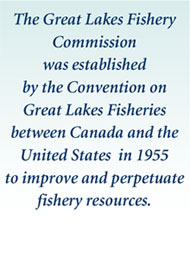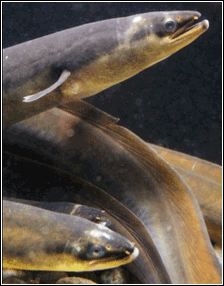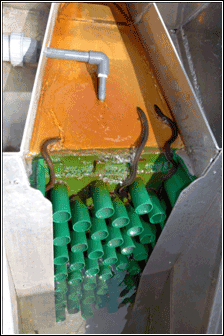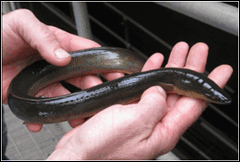

USGS scientist takes aim at Great Lakes invaders
Rising Higher: A Research Lab Built from the Ground Up - Part 2
Great Lakes Researchers Go Down Under
Rising Higher: A Research Lab Built from the Ground Up - Part 1
A Monograph on Ciscoes of the Laurentian Great Lakes and Lake Nipigon
WATCH: Acoustic Telemetry Provides In-Depth Look into Fish Behavior
Eel-Ladder Style Traps: A New Lamprey Control Tool
A Lampricide Treatment: Up-Close
Lamprey Nativeness Claims Annulled by Commission's Eshenroder
A Population at the Edge: American Eel Declining at the Extremes
Celebrating 60 Years of Successful Sea Lamprey Control, Science, and Cross-Border Collaboration!
Great Lakes Scientists Use Acoustic Telemetry to Reveal the Secret Lives of Fish
Hammond Bay Biological Station: The Nexus for Research and Restoration on the Great Lakes
Big Consequences of Small Invaders
New Sea Lamprey Estimates Suggest a Dramatically Decreased Population
Conducting Research through Cooperative Partnerships: The PERM Agreement
Living on the Edge: A Closer Look at Coastal Communities
Asian Carp: The War Isn't Over
Managing the Lake Huron Fishery
Understanding Sea Lamprey: Mapping the Genome and Identifying Pheromones

American Eels in Peril
The heat is on to prevent the loss of a native Great Lakes fish
By Marc Gaden and John Dettmers, Great Lakes Fishery Commission
The collapse in American eel populations has been rapid and severe, and the Great Lakes are in danger of losing a native species. Scientists and fishery managers have been working together to mount a response to this crisis before recovery becomes impossible.
An Impressive Journey
The American eel is widespread and migrates extensively throughout North America. Prior to the construction of the Welland Canal, Lake Ontario was an extremity of its native range. Today, it is not unheard of to see American eels as far west as Duluth and Thunder Bay.
Eels are catadromous meaning they primarily live in rivers and lakes but migrate out to the Sargasso Sea to spawn. The full-circle journey from larvae to spawner could span more than twenty years, cover thousands of miles, and involve life in both marine and freshwater environments.
Eels in Danger
Harvested at various stages of their life cycle for aquaculture, bait, and food, the American eel is seriously threatened throughout its journey. Migrating adult eels face dams and blockages that prevent access to freshwater habitat, and gnawing hydroelectric power turbines obstruct their return to the Sargasso Sea to spawn.
Research indicates that American eels in the Great Lakes and St. Lawrence system have declined by more than three orders of magnitude since 1982. While it was common in the early 1980s for more than 20,000 American eels to navigate the eel ladder at the Moses-Saunders power facility per day during their peak migration, today, only a few eels per week are seen at the ladder.
Stopping the Decline
Managing American eels, preventing the decline, and restoring their populations are complex undertakings. Given the range of the American eel, management is difficult because at least twenty-five state, provincial, and federal governments must work together in a highly coordinated fashion. A major challenge has been simply to get these governments to agree that there is a problem.
In 2007, the Great Lakes Fishery Commission's Council of Lake Committees (comprising state, provincial, and tribal jurisdictions) formed the American Eel Task Group, which was directed to work with other state, provincial, and federal agencies to develop a bi-national recovery framework that will form the basis for coordinated action.
At the management level, the positive news is that American eels stocked into the upper St. Lawrence River and Lake Ontario have been surviving well and growing quickly. Unfortunately, while the commercial fishery on Lake Ontario has been closed, eels are still commercially harvested in the St. Lawrence River and Atlantic Ocean.
As eels migrate to the ocean to spawn, more steps must be taken to ensure safe downstream passage. The Great Lakes Fishery Commission and its state and provincial partners continue efforts to establish a comprehensive and coordinated management response that addresses all sources of eel mortality. The commission is also supporting research investigating the genetic structure of eels so that biologists can tailor management strategies to best protect and restore eels in North America.
A Species that Must be Protected
Few Great Lakes/St. Lawrence species are in as much trouble as the American eel. Throughout its range, the eel faces threats from harvest at all life stages and mortality due to hydropower facilities. American eel protection and recovery is indeed a wide-ranging, multi-generational effort. We must take these steps now and persistently into the future to prevent the loss of this native species.
For more information about American eel: Eels at the Edge: Science, Status, and Conservation Concerns edited by John Casselman and David Cairns, American Fisheries Society Symposium 58, American Fisheries Society, Bethesda, Maryland, 2009.

The American eel is imperiled throughout its range, including in the Great Lakes and the St. Lawrence River. PHOTO: OMNR

Juvenile eels are able to bypass the Moses-Saunders dam by swimming through the eel ladder, the largest of its kind in the world. PHOTO: NY POWER AUTHORITY

American eel are a unique and versatile fish species. Current research and management efforts are focused on better understanding their life cycle and identifying the key causes for their decline. PHOTO: ON POWER GENERATION



